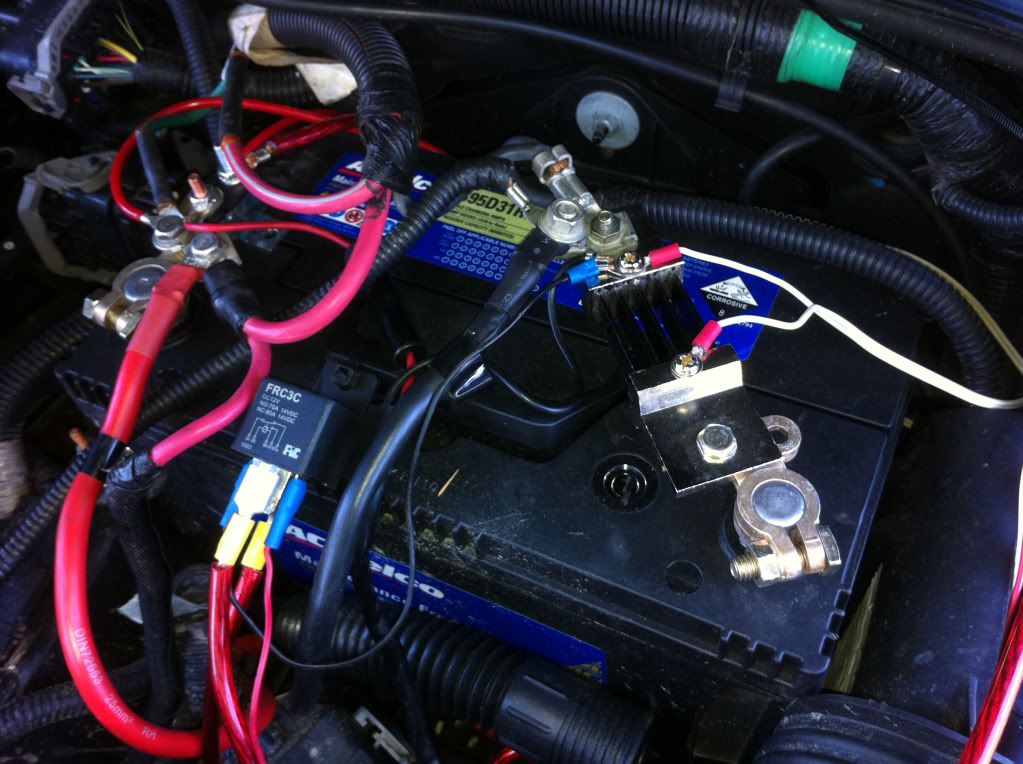Installing an Ammeter - Hunty
#1
Hi Guyz
I have recently added 5 more 100w lights to my JK and was wondering how my alternator was coping, I also wanted to know just how much strain my winch was placing on my Alternator, battery and electrical system at different levels of Pull!
I now have 900w of light (Hi Beam) and according to my new Ammeter I am using 61amps out of a total of 160 (yes I got lucky and my jeep has a 160amp alternator)
To save you all the pain I went through - heres a couple of tips
1. buy a ammeter and shunt that reads up to 500Amps
2. if you buy off Ebay as I did and they don't supply any instructions or wiring diags then pls only connect the shunt between the battery neg and the jeep - eg disconnect the black wire from the battery and insert the shunt!
3.be very careful to connect the sensor wires to the shunt with the correct polarity - if you don't you will need to buy a replacement Ammeter with a few seconds!
Warning - Science content - What is a shunt - well (pls post up electronic guru's if you can explain it better) it is a device with a tiny amount of resistance (75ma) so if you connect a load - (in my case 900w of light) to a battery and you connect through a shunt the voltage that you can read at the battery will be (if the battery is full) 13.8v and if you measure the voltage after it has gone through the shunt it will be approx .006v less - this tiny discrepancy is translated by the ammeter and displayed (in my case) as 61amps. - sorry for the science content Jeepers - LoL - but i'm sure at 1 person wants to now!
So next time I go wheelin and use my winch I will be able too see how many amps it sucks down.
cheers Hunty




I have recently added 5 more 100w lights to my JK and was wondering how my alternator was coping, I also wanted to know just how much strain my winch was placing on my Alternator, battery and electrical system at different levels of Pull!
I now have 900w of light (Hi Beam) and according to my new Ammeter I am using 61amps out of a total of 160 (yes I got lucky and my jeep has a 160amp alternator)
To save you all the pain I went through - heres a couple of tips
1. buy a ammeter and shunt that reads up to 500Amps
2. if you buy off Ebay as I did and they don't supply any instructions or wiring diags then pls only connect the shunt between the battery neg and the jeep - eg disconnect the black wire from the battery and insert the shunt!
3.be very careful to connect the sensor wires to the shunt with the correct polarity - if you don't you will need to buy a replacement Ammeter with a few seconds!
Warning - Science content - What is a shunt - well (pls post up electronic guru's if you can explain it better) it is a device with a tiny amount of resistance (75ma) so if you connect a load - (in my case 900w of light) to a battery and you connect through a shunt the voltage that you can read at the battery will be (if the battery is full) 13.8v and if you measure the voltage after it has gone through the shunt it will be approx .006v less - this tiny discrepancy is translated by the ammeter and displayed (in my case) as 61amps. - sorry for the science content Jeepers - LoL - but i'm sure at 1 person wants to now!
So next time I go wheelin and use my winch I will be able too see how many amps it sucks down.
cheers Hunty




#4
#5
#6
In this case a shunt is a known resistor value. What the meter does is measure the voltage drop across this known resistor value and if you divide the voltage drop by the resistor value you get the current (amps).
If you multiply the current that the lamps draw (61) by the voltage going to the lamps (13.8) you can calculate the true power consumption of your load (841.8 watts).
If you multiply the current that the lamps draw (61) by the voltage going to the lamps (13.8) you can calculate the true power consumption of your load (841.8 watts).
#7
Originally Posted by Tiki Tim
In this case a shunt is a known resistor value. What the meter does is measure the voltage drop across this known resistor value and if you divide the voltage drop by the resistor value you get the current (amps).
If you multiply the current that the lamps draw (61) by the voltage going to the lamps (13.8) you can calculate the true power consumption of your load (841.8 watts).
If you multiply the current that the lamps draw (61) by the voltage going to the lamps (13.8) you can calculate the true power consumption of your load (841.8 watts).
Trending Topics
#8
I was thinking the headlights would be 20 amps or less.
edit:
oops! I assumed "Hi Beam" meant the stock lights only. You are including all the extra lights, too. Correct?
Last edited by ronjenx; 11-24-2010 at 08:08 AM.
#9
#10




 am I right?
am I right?